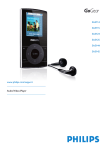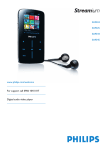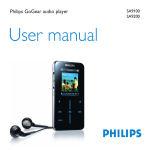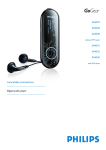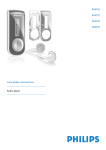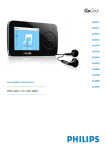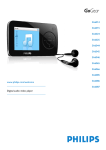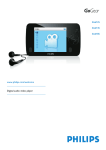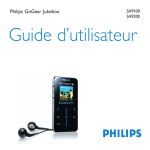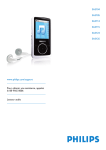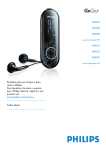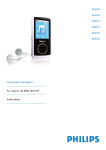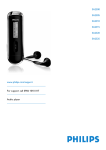Download Philips SA5125 2GB* Flash audio video player
Transcript
SA5114 SA5115 SA5124 SA5125 SA5144 SA5145 www.philips.com/support Digital audio video player Need help? Please visit www.philips.com/support where you can access to a full set of supporting materials such as user manual, flash tutorial, the latest software upgrades and answers to frequently asked questions. Or call our Customer Care Helpline, where our professional support team will be pleased to assist you in solving any issues you may have with your player. Helpdesk Tariff / min Keep ready Austria Belgium Czech Republic Denmark Finland France Germany Greek 0820 901115 070 253 010 800142100 35 25 87 61 09 2290 1908 08 9165 0006 0180 5 007 532 0 0800 3122 1223 €0.20 €0.17 Místní tarif Lokal tarif Paikallispuhelumaksun hinta €0.23 €0,14 1 a a Hungary Ireland Italy Luxemburg Netherlands Norway Poland 06 80 018544 01 601 1161 199 404 042 26 84 30 00 0900 0400 063 2270 8250 022 3491504 Portugal Russia 2 1359 1440 (495) 961-1111 8 800 200-0880 Helyi tarifa Local tariff €0.25 Tarification locale €0.20 Lokal tariff Cena połączenia lokalnego Preço local Das Kaufdatum. Modellnummer und Seriennummer La date d’achat la référence et le numéro de série du produit Datum zakoupení, číslo modelu a sériové číslo Indkøbsdato, type-, model- og serienummer Ostopäivä ja tarkka mallinumero ja sarjanumero La date d’achat la référence et le numéro de série du produit Das Kaufdatum. Modellnummer und Seriennummer A vásárlás dátuma, modell szám és szériaszám Date of Purchase. Model number and Serial number La data di acquisto, numero di modello e numero di serie La date d’achat, la référence et le numéro de série du produit De datum van aankoop, modelnummer en serienummer Datoen da du kjøpte produktet & modellnummer & serienummeret Data zakupu, Numer modelu i numer seryjny Slovakia Spain Sweden Switzerland UK 0800004551 902 888 785 08 632 0016 02 2310 2116 0906 1010 017 Country Europe по России звонок бесплатный Miestna tarifa €0,15 Lokal kostnad Ortstarif £0.15 A data de compra, número do modelo e número de série Дата покупки, Номер модели и Серийный номер Dátum zakúpenia, číslo modelu a sériové číslo Fecha de compra y número del modelo y número de serie Inköpsdatum, modellnummer och serienummer Das Kaufdatum. Modellnummer und Serial nummer Date of Purchase, Model number and Serial number North America Canada USA 1-800-661-6162 (Francophone) 1-888-744-5477 (English / Spanish) 1-888-744-5477 Free Date of Purchase, Model number and Serial number Free Date of Purchase, Model number and Serial number 11 4544 2047 0800 701 02 03 (Except Sao Paulo) 2121 0203 (Sao Paulo) 600 744 5477 01 800 504 6200 Tarifa local Grátis Fecha de compra y número del modelo y número de serie A data de compra, número do modelo e número de série South America Argentina Brazil Chile Mexico Asia China Hong Kong Korea Thailand ii 4008 800 008 2619 9663 02 709 1200 66 2 652 8652 Preço local Tarifa local Gratis Fecha de compra y número del modelo y número de serie Fecha de compra y número del modelo y número de serie Contents 1 2 2.1 2.2 2.3 3 3.1 3.2 3.3 3.4 3.4.1 3.4.2 3.5 3.6 3.7 3.7.1 4 4.1 4.1.1 4.1.2 4.1.3 4.1.4 4.2 4.2.1 4.2.2 4.2.3 4.2.4 4.3 4.3.1 4.3.2 4.3.3 4.3.4 4.3.5 4.3.6 4.4 4.4.1 4.4.2 4.4.3 4.4.4 4.5 4.5.1 4.5.2 4.5.3 Important safety information Your new player What’s in the box Optional accessories Register your product Getting started Overview of controls and connections Main menu Install Connect and charge Use the supplied USB cable Battery level indication Transfer music and pictures Transfer video Enjoy Power on and off 3 7 7 7 7 8 8 9 9 10 10 11 11 12 13 13 Organize and transfer music and pictures with Windows Media Player 11 14 About Windows Media Player 11 Before installing Windows Media Player 11 (optional) Installing Windows Media Player 11 Rolling back to a previous version of Windows Media Player More about rolling back to a previous version of Windows Media Player Music and pictures transfer 14 15 16 19 20 20 Add music and picture files to Windows Media Player Library 21 Switch between music and pictures library in Windows Media Player and your player 22 Rip songs from a CD 23 Buy music online 25 Sync your Windows Media contents to your player Set up your player Switch Between Automatic and Manual Sync Select and Prioritise What Syncs Automatically Select files and playlists for Manual Sync Shuffle manual sync items on your player Copy files from your player to your computer Manage your Windows Media Player Playlist Create a regular Playlist Create an Auto Playlist Edit playlist Transfer playlists to your player 26 26 27 27 28 30 31 31 31 32 33 35 Manage your files and playlists in Windows Media Player 35 Search for music or pictures via Windows Media Player Delete files and playlists from Windows Media Player library Delete files and playlists from your player 35 35 35 1 Contents 4.5.4 4.5.5 4.5.6 5 5.1 Detailed operation Music mode 36 37 38 39 39 5.1.1 5.1.2 5.1.3 5.1.4 Controls Find your music Album art Play mode 39 40 41 41 5.2 5.3 Sound settings Playlist on the go 42 42 5.3.1 5.3.2 5.3.3 5.3.4 5.3.5 5.4 5.5 5.5.1 5.5.2 5.5.3 5.6 5.6.1 5.6.2 5.7 5.7.1 5.7.2 5.7.3 5.7.5 5.7.6 5.7.7 5.7.8 5.8 5.9 5.9.1 5.9.2 5.9.3 5.9.4 5.9.5 5.9.6 5.10 5.11 6 6.1 7 8 9 2 Add or change album art Edit song information via Windows Media Player Format your player via Windows Media Player Add songs to playlist on the go Play back playlist on the go Save Playlist on the go Clear playlist on the go Remove songs from Playlist on the go Most played Other playlists Delete playlist from your player Rate your songs Now playing Videos Find your Videos Controls Pictures Transfer pictures from your computer to your player Transfer pictures from your player to your computer Find pictures on your player Slideshow Start a slideshow Customize slideshow settings Slideshow music Delete Media Radio Connect the headphones Select your FM region Auto tune Play a preset radio station Manual Tuning Save a station as preset Settings Use your player to store and carry data files Update your player Manually verify whether your firmware is up to date Frequently asked questions Technical data Glossary 43 43 44 44 45 45 46 46 46 47 48 48 49 50 50 50 51 51 51 52 52 53 53 53 53 54 54 54 55 55 58 59 59 60 63 65 1 Important safety information General maintenance To avoid damage or malfunction: • Do not expose the player to excessive heat caused by heating equipment or direct sunlight. • Do not drop your player or allow objects to fall on your player. • Do not allow your player to be submerged in water. Do not expose headphone socket or battery compartment to water, as water entering the set may cause major damage. • Do not use any cleaning agents containing alcohol, ammonia, benzene, or abrasives as these may harm the set. • Active mobile phones in the vicinity may cause interference. • Backup your files. Please ensure that you retain the original files you have downloaded to your device. Philips is not responsible for any loss of data if the product becomes damaged or not readable / legible. • Manage (transfer, delete, etc.) your music files only with the supplied music software to avoid problems! About operating and storage temperatures • Operate in a place where temperature is always between 0 and 35ºC (32 to 95ºF) • Store in a place where temperature is always between -20 and 45ºC (-4 to 113ºF) • Battery life may be shortened in low temperature conditions. Replacements parts/ accessories Visit www.philips.com/support or www.philips.com/welcome (for US residents) or contact our Customer Care Helpline (the telephone number can be found on the first page of this manual) to order replacement parts/ accessories. Hearing Safety Listen at a moderate volume. • Using headphones at a high volume can impair your hearing. This product can produce sounds in decibel ranges that may cause hearing loss for a normal person, even for exposure less than a minute. The higher decibel ranges are offered for those that may have already experienced some hearing loss. • Sound can be deceiving. Over time your hearing “comfort level” adapts to higher volumes of sound. So after prolonged listening, what sounds “normal” can actually be loud and harmful to your hearing. To guard against this, set your volume to a safe level before your hearing adapts and leave it there. To establish a safe volume level: • Set your volume control at a low setting. • Slowly increase the sound until you can hear it comfortably and clearly, without distortion. 3 Listen for reasonable periods of time: • Prolonged exposure to sound, even at normally “safe” levels, can also cause hearing loss. • Be sure to use your equipment reasonably and take appropriate breaks. Be sure to observe the following guidelines when using your headphones. • Listen at reasonable volumes for reasonable periods of time. • Be careful not to adjust the volume as your hearing adapts. • Do not turn up the volume so high that you can’t hear what’s around you. • You should use caution or temporarily discontinue use in potentially hazardous situations. • Do not use headphones while operating a motorized vehicle, cycling, skateboarding, etc.; it may create a traffic hazard and is illegal in many areas. Important (for models supplied with headphones): Philips guarantees compliance with the maximum sound power of its audio players as determined by relevant regulatory bodies only with the original model of provided headphones. In case this one needs replacement, we recommend that you contact your retailer to order a model identical to that of the original, provided by Philips. Copyright information All other brands and product names are trademarks of their respective companies or organizations. Unauthorized duplication of any recordings whether downloaded from the Internet or made from audio CDs is a violation of copyright laws and international treaties. The making of unauthorized copies of copy-protected material, including computer programmes, files, broadcasts and sound recordings, may be an infringement of copyrights and constitute a criminal offence. This equipment should not be used for such purposes. This product is protected by certain intellectual property rights of Microsoft Corporation. Use or distribution of such technology outside of this product is prohibited without a license from Microsoft or an authorized Microsoft subsidiary. Content providers are using the digital rights management technology for Windows Media contained in this device (“WM-DRM”) to protect the integrity of their content (“Secure Content”) so that their intellectual property, including copyright, in such content is not misappropriated. This device uses WM-DRM software to play Secure Content (“WM-DRM Software”). If the security of the WM-DRM Software in this device has been compromised, Microsoft may revoke (either on its own or upon the request of the owners of Secure Content (“Secure Content Owners”)) the WM-DRM Software’s right to acquire new licenses to copy, display and/or play Secure Content. Revocation may also prevent your device’s ability to transfer, store, copy, display and/or play Secure Content which you have previously stored on your Device. Revocation does not alter the WM-DRM Software’s ability to play unprotected content. A list of revoked WM-DRM Software is sent to your device whenever you download a license for Secure Content from the Internet or from a PC. Microsoft may, in conjunction with such license, also download revocation lists onto your device on behalf of Secure Content Owners, which may disable your device’s ability to copy, display and/or play Secure Content. 4 In the event of revocation, Philips will attempt to make available software updates to restore some or all of your device’s ability to transfer, store, access, copy, display and/or play Secure Content. However, the ability to make such updates available does not rest solely with Philips. Philips does not guarantee that, after revocation, such software updates will be available. If such updates are not available, your device will not have the ability to transfer, store, copy, display and/or play Secure Content - even Secure Content which you have previously stored on your device. In addition, even if such software updates are available, they may not enable your Device to transfer, store, copy, display, and/or play Secure Content which was previously stored on your Device. In some cases you may be able to transfer the content from the PC. In other cases, you may have to repurchase previously obtained Secure Content. To summarize - Microsoft, Secure Content Owners, and Secure Content distributors may deny you access, or restrict your access, to Secure Content. They may also disable your device’s ability to transfer, store, copy, display and/or play Secure Content even after you have paid for and obtained it. Neither your consent nor the consent or approval of Philips is necessary for any of them to deny, withhold or otherwise restrict your access to Secure Content or to disable your device’s ability to transfer, store, access, copy, display, and/or play Secure Content. Philips does not guaranty that you will be able to transfer, store, access, copy, display, and/or play Secure Content. The Windows Media and the Windows logo are registered trademarks of Microsoft Corporation in the United States and/or other countries. Data logging Philips is committed to improving the quality of your product and enhancing the Philips user experience. To understand the usage profile of this device, this device logs some info / data to the non-volatile memory region of the device. These data are used to identify and detect any failures or problems you as a user may experience while using the device. The data stored, for example, will be the duration of playback in music mode, duration of playback in turner mode, how many times battery low was encountered, etc. The data stored do not reveal the content or media used on the device or the source of downloads. The data stored on the device are retrieved and used ONLY if the user returns the device to the Philips service centre and ONLY to simplify error detection and prevention. The data stored shall be made available to user on user’s first request. Disposal of your old product Your product is designed and manufactured with high quality materials and components, which can be recycled and reused. When this crossed-out wheeled bin symbol is attached to a product, it means the product is covered by the European Directive 2002/96/EC. Please be informed about the local separate collection system for electrical and electronic products. 5 Please act according to your local rules and do not dispose of your old product with your normal household waste. The correct disposal of your old product will help prevent potential negative consequences to the environment and human health. Modifications Modifications not authorized by the manufacturer may void user authority to operate this device. Notice for USA Note: This equipment has been tested and found to comply with the limits for Philips SA5114 SA5115 a Class B digital device, pursuant to part 15 of the FCC Rules. These SA5124 SA5125 SA5144 SA5145 limits are designed to provide reasonable protection against harmful interference in a residential installation. This equipment generates, uses, and can radiate radio frequency energy and, if not installed and used in accordance with the instruction manual, may cause harmful interference to radio communications. However, there is no guarantee that interference will not occur in a particular installation. If this equipment does cause harmful interference to radio or television reception, which can be determined by turning the equipment off and on, the user is encouraged to try to correct the interference by one or more of the following measures: - Relocate the receiving antenna. - Increase the separation between the equipment and receiver. - Connect the equipment into an outlet on a circuit different from that to which the receiver is connected. - Consult the dealer or an experienced radio/ TV technician for help. Notice for Canada This Class B digital apparatus complies with Canadian ICES-003. The set complies with the FCC-Rules, Part 15 and with 21 CFR 1040.10. Operation is subject to the following two conditions: • This device may not cause harmful interference, and • This device must accept any interference received, including interference that may cause undesired operation. Notice for the European Union This product complies with the radio interference requirements of the European Union. 6 2 Your new player With your newly purchased player, you can enjoy the following: • MP3 and WMA playback WMA support includes Widows Media DRM protected WMA (download to own and subscription content) from online stores. • Video (WMV) playback You can use Media Converter (provided in (CD-ROM) to convert other video formats (nonprotected) to WMV. WMV support includes Widows Media DRM protected WMV (download to own, subscription and rental content) from online stores. • FM radio • Picture viewing 2.1 What’s in the box The following accessories are included with your player: Philips GoGear audio player Quick start guide EN FR ES DE Quick start guide Guide de démarrage rapide Guía de inicio rápido Kurzanleitungsanleitung 1 11 21 31 NL IT SV RU SA5114 SA5115 SA5124 SA5125 SA5144 SA5145 Handleiding voor snel gebruik Guida di riferimento rapido Snabbstartsinstruktioner Быстрый запуск 41 51 61 71 1 Install 2 Connect and charge 3 Transfer 4 Enjoy Player Headphones USB cable Quick start guide CD-ROM containing Windows Media Player 11, Philips Device Manager, MediaConverter for Philips, User Manual and Frequently Asked Questions 2.2 Optional accessories You can find optional accessories at www.philips.com/GoGearshop (Europe) or www.store.philips.com (USA) 2.3 Register your product We strongly recommend that you register your product in order to gain access to free upgrades. To register your product, please log on to www.philips.com/register or www.philips.com/welcome (for US residents) so that we can inform you as soon as new updates become available. 7 3 Getting started 3.1 Overview of controls and connections 1 2 3 4 5 6 7 Press LOCK 2; J( )K + VOLUME 1 2 3/4 MENU 8 8 9 10 11 12 13 1 Up key 2 Rewind / previous key 3 Play / pause key On / Off key 4 Left / back key 5 MENU key 6 Down key 7 USB connector 8 Headphones jack 9 LOCK key 10 Right / select key 11 Forward / next key 12 Volume up / down bar 13 Reset To Lock all control keys Play/Pause songs Press and hold to power on / off Move back to previous song Fast rewind Jump to next song Fast forward Control volume Return to previous menu/option Select option Go to next option Scroll through lists Access list of menu options 3.2 Main menu Menu Music Videos Pictures Radio Settings Now Playing To Play your digital music tracks Watch your videos View pictures Listen to FM radio Customize the settings of your player Go to the play screen 3.3 Install Important Make sure to install the software provided in the supplied CD before connecting your player. System requirements: • • • • • • • • Windows XP (SP2) or Vista Pentium III 800MHz processor or higher 256MB RAM 200MB hard disk space Internet connection (preferable) Microsoft Internet Explorer 6.0 or later CD-ROM drive USB port Important This is critical to ensure the proper working of your player when connected to the PC. For Windows XP users In order to run this software, you need to have Windows XP Service Pack 2 (SP2) installed on your PC. If you do not , you will be prompted to do so. When installation is completed, connect device to PC. For Vista N users in Europe Install Media Restore Pack on your PC before using your device. This can be done by downloading and installing Windows Media Player 11 for XP from the Microsoft website at the following link. http://www.microsoft.com/windows/windowsmedia/download/AllDownloads.aspx Select Windows Media Player , Version 11 for XP and the language of your choice." 1 Insert the CD supplied with your product into the CD ROM drive of your PC. 2 Follow the on-screen instructions to complete the installation of Windows Media Player, MediaConverter for Philips and Philips Device Manager. 3 If the installation program does not start automatically, browse the CD contents via Windows Explorer and double click on the Start.exe file. Lost your CD? Don’t worry, you can download the CD contents from www.philips.com/support or www.philips.com/welcome (for U.S. residents). 9 3.4 Connect and charge Your player will be charged when connected to the PC. 3.4.1 Use the supplied USB cable Connect the supplied USB cable to PC for charging and data transfer. However, your PC must have hi-power capability in order to perform charging. Note Charge your player for at least 5 hours before using it for the first time. The battery* will be fully charged (100%) in 5 hours and 70% charged in one hour for quick charge. The player is fully charged when the charging animation stops and is displayed. Your fully charged player will allow up to 20 hours* of music playback or 2 hours* of video playback. * 10 Rechargeable batteries have a limited number of charge cycles and may eventually need to be replaced. Battery life and number of charge cycles vary by use and settings. 3.4.2 Battery level indication The approximate power levels of your battery are indicated as follows: Battery is full Battery is two-thirds full Battery is half full Battery is low Battery is empty When the battery is nearly empty, the following power low warning screen will blink and emit a beep tone. When you hear a double beep, your player will power down in less than 10 seconds. Note All settings will be saved before the player shuts down. 3.5 Transfer music and pictures You can transfer music and pictures to your player using Windows Media Player. See Organize and transfer pictures and music with Windows Media Player 11 section of this user manual for more details. 11 3.6 Transfer video Important If you have DRM protected videos on your PC, make sure that you play them at least once in Windows Media Player before transferring to your player using MediaConverter for Philips. Use MediaConverter for Philips to convert the video files to the correct screen size and transfer videos from your PC to your player. This application will convert your video files to the right format and resolution before transferring them to your player so that they are guaranteed to playback on your player without any problems. 1 Connect your player to the PC via the supplied USB cable. 2 Start MediaConverter for Philips by clicking this icon on your desktop. Note Video conversion and transfer is usually a long process and dependent on your PC configuration. Please be patient while this happens. 5 7 4 3 In the Convert to: option at the bottom of the screen, select Current Device, the contents will be stored directly on the connected player. 4 Press the Add Media button to select your video files. 5 Press OPEN when you have found the video files on your PC that you want to transfer to the player. You may also add additional video files. OR Select the files in Windows explorer and then drag and drop them into the MediaConverter for Philips screen. 6 Press Convert. Note If needed, the files will first be converted to a format that can be played on the player. > All the converted files will be transferred to the player. 12 7 The progress of conversion and transfer is shown 3.7 Enjoy 3.7.1 Power on and off To power on, press and hold On/Off (2;) key until the Philips welcome screen appears. To power off, press and hold On/Off (2;) key until the player powers off. Note Your player automatically powers off if there is no operation or music played for 10 minutes. The last playback status and screen will be resumed the next time it is powered on within 30 minutes of the last power off. 13 4 Organize and transfer music and pictures with Windows Media Player 11 4.1 About Windows Media Player 11 While your player will work with Windows Media Player 10, we suggest that you use Windows Media Player 11 for a more enhanced media experience, both on the computer and on your player. Windows Media Player 11 is an all-in-one playback and recording program that lets you play your CDs, rip CD tracks to your hard disk, transfer media files to your player, etc. This chapter describes the steps that you need to follow to successfully set up and transfer music and pictures to your player. For more information, see Windows Media Player Help on your computer or visit www.microsoft.com/windows/windowsmedia/player/faq/default.mspx Important Make sure that you have installed the Windows Media Player 11 software provided in the by-packed CD for music and picture transfer. Although Windows Media Player also lets you transfer video files from your computer to the player, please use the MediaConverter for Philips provided in the by-packed CD for video transfers. For more information regarding transfer of videos, see 3.6 Transfer video. Important You must be logged on as an administrator or a member of the Administrators group to perform the following procedures. For more information, please visit www.microsoft.com 14 4.1.1 Before installing Windows Media Player 11 (optional) If necessary, before you install Windows Media Player 11, go to Windows Update and install any high-priority updates that are available for your computer. Perform the following steps if you wish to save media information and star ratings to your media file, as well as back up your existing data: 1 In Windows Media Player 10, click Tools, and then click Options. 2 Click the Library tab, select the Maintain my star ratings as global ratings in the media files check box. > The user ratings for your songs will be saved in your media files rather than in your library database file (this may take several minutes). 3 Click Tools, and then click Process media information now. > This ensures that your ratings (and any changes that you have made to other media information) are saved to your media files immediately. 4 Select Start > All Programs > Accessories > System Tools > Backup to backup your existing data. 15 4.1.2 Installing Windows Media Player 11 1 Insert the by-packed CD into the CD ROM drive of your computer. Note If the installation program does not start automatically, browse the CD contents via Windows Explorer and run the program by double clicking on the file ending with .exe. 2 Follow the onscreen instructions to complete the installation of Windows Media Player 11. Note If the following dialog boxes appear during installation, read through the texts before you proceed with the installation: 3 Click Validate to continue. 16 4 Click I Accept to continue. 5 Select EXPRESS and click Finish. 17 Note Your existing media library is currently migrating to Windows Media Player 11. This may take several minutes depending on the size of your existing media library. 6 Click on the checkboxes to select the file types that you want Windows Media Player to play by default or click Select all and then click Finish. 18 7 Click on the checkboxes to select your privacy options and then click Next to complete the necessary settings. 4.1.3 Rolling back to a previous version of Windows Media Player If you encounter some problems with Windows Media Player 11, you can simply roll back to the version that was previously on your computer. 1 Disconnect your player from your computer. 2 Select Start, and then click Control Panel. 3 In the Control Panel, select Add or Remove Programs. 4 Select Windows Media Player 11, and then click Remove. > A confirmation dialog box appears. 5 Click OK. 6 When the rollback process is completed (this may take several minutes), click Restart. 7 Select Start, and then click Control Panel. 8 In the Control Panel, select Add or Remove Programs. 9 Select Windows Media Format 11 Runtime, and then click Remove. > A confirmation dialog box appears. 10 Click OK. > A second confirmation dialog box appears. 11 Click OK. 19 12 When the rollback process is completed (this may take several minutes), click Restart. 13 Select Start, and then click Control Panel. 14 In the Control Panel, select Add or Remove Programs. 15 Select Microsoft User-Mode Driver Framework Feature Pack 1.0, and then click Remove. 16 Follow the instructions that appear in the Software Update Removal Wizard. 17 If the Wudf01000 confirmation dialog box appears, click Yes to continue. When the software removal process is completed (this might take several minutes), click Finish. 4.1.4 More about rolling back to a previous version of Windows Media Player If you roll back to a previous version of Windows Media Player, and your player becomes undetectable by Windows or Windows Media Player, perform the following procedures: 1 Switch on your player and connect it to your computer using the supplied USB cable. 2 Right-click My Computer, and then click Manage. 3 In the left pane, click Device Manager. 4 In the right pane, click on the "+" sign beside Portable Devices. 5 Right-click GoGear SA51xx, and then click Uninstall. 6 In the confirmation dialog box, click OK to uninstall the player. 7 Disconnect your player from your computer, make sure it is still switched on, and then connect it to your computer again. > Windows will detect your device and automatically re-install it. Within a minute or two, GoGear SA51xx will reappear in the Portable Devices section of Device Manager. 4.2 Music and pictures transfer You can view and manage your music and picture files using Windows Media Player. Important We recommend that you always use Windows Media Player to transfer music and pictures to your player. 20 4.2.1 Add music and picture files to Windows Media Player Library By default, Windows Media Player automatically loads all the music and picture files stored in your My Music and My Pictures folders into the library. If you add new files to these folders, they will also be automatically added to the library. Add music and picture files that are stored elsewhere on your computer or computer network 1 Select Start > All Programs > Windows Media Player to launch Windows Media Player program. 2 Click the down arrow beneath the Library tab and select Add to Library ... > Add to Library dialog box appears. 3 Click <<Advanced Options to expand the dialog box. 21 4 Click Add... > Add folder dialog box appears. 5 Select a folder in which you have kept your music or picture files and click OK. 6 Return to Add to library dialog box and click OK. > Windows Media Player will start scanning the folder and add available music or picture files to the library. 7 Click Close when done. Tip Windows Media Player is configured to skip audio files that are smaller than 100KB. To include files smaller than 100KB, you can change the default settings within the Add to library dialog box. 4.2.2 Switch between music and pictures library in Windows Media Player and your player To switch between music and pictures library, simply click the arrow on the top left of Windows Media Player and select the category you want to view. 22 4.2.3 Rip songs from a CD If you want to transfer music from a CD to your player, you need to create a digital copy of the music on your computer first. This is called Ripping. 1 Start Windows Media Player. 2 Click the down arrow beneath the Rip tab and select Format to choose the format you want. 3 Click the down arrow beneath the Rip tab and select Bit Rate to choose the bit rate you want. Tip A higher bit rate produces a better sound quality, but the file size will be larger. The recommended format for yourplayer is 128kbps MP3 or 64kbps WMA. 23 4 Insert the Audio CD into your computer's CD drive. > All the tracks from the CD are listed. By default, Windows Media Player will start to rip all the songs in the CD. To modify this option, click the down arrow beneath the Rip tab and select Rip CD Automatically When Inserted > Never. Important Make sure that you are connected to the Internet before you start ripping so that Windows Media Player can download the album and track information from an online music database. If your computer is not connected to the Internet, you will have to enter the album and track information manually. As Windows Media Player may not always identify the right song on the CD and the online music database may not always have the correct information (especially for new album releases or albums from lesser-known artists), you may need to manually edit or enter the album and track information. See Edit song information via Windows Media Player. 24 5 Select the songs that you want to rip by clicking on the checkboxes. 6 Click Start Rip. > The selected tracks will be converted and added to Windows Media Player library. 4.2.4 Buy music online If you want to buy music online, you need to select a music store. 1 Start Windows Media Player. 2 Click the down arrow beneath the Media Guide tab and select Browse all Online Stores. 3 Choose a store and follow the on-screen instructions. 25 Note Depending on where you are and the language used, the list of stores may differ from what is shown here. > After you have bought a song or an album, it will appear in Windows Media Player library. 4.3 Sync your Windows Media contents to your player You can sync your music and pictures to your player using Windows Media Player. Simply connect your player to your computer using the supplied USB cable, set up sync, and you will be ready to sync your media library to the player. When you connect your player to the computer for the first time, Windows Media Player automatically selects the sync method (automatic or manual) that works best for your player. Automatic: If your player has sufficient storage space (at least 4GB of free space) and your entire media library can fit on your player, your entire media library will be automatically copied to your player as soon as you connect it to your computer. Manual: If your entire media library cannot fit on the player, then you will be prompted to manually select specific files or playlists that you want to transfer to your player. 4.3.1 Set up your player 1 Start Windows Media Player. 2 Switch on your player and then connect it to your computer using the supplied USB cable. > If prompted, select the option to sync the device using Windows Media Player. 3 If Windows Media Player selects to sync your device automatically, click Finish. > Your entire library will sync to your player. Thereafter, every time you connect your player to your computer, your player will sync automatically. You can also select and prioritise what syncs automatically (see Select and Prioritise What Syncs Automatically). 4 If Windows Media Player selects to sync your device manually, click Finish. > You then need to click the Sync tab and select the files and playlists you want to sync manually (see 4.3.4 Select files and playlists for Manual Sync). Important Do not disconnect your player while transferring is in progress. If you disconnect your player, the transfer will not be complete and Windows might not be able to recognize your player afterwards. To rectify this problem, perform steps 1 - 7 in 4.1.3 More about rolling back to a previous version of the Player. 26 4.3.2 Switch Between Automatic and Manual Sync After your player is set up the first time, depending on your preference, you can switch between automatic and manual sync. 1 Click the down arrow beneath the Sync tab, select Philips GoGear SA51xx > Set Up Sync. 2 Select or clear the Sync this device automatically check box. 4.3.3 Select and Prioritise What Syncs Automatically If Windows Media Player has selected to sync your device automatically, you can choose not to sync your entire media library. You can choose what you wish to sync from existing playlists or create new playlists. These playlists you have selected will then sync to your player every time you connect it to your computer. 1 Click the down arrow beneath the Sync tab and select Philips GoGear SA51xx > Set Up Sync. > The Device Setup dialog box appears. 2 In the Available playlists pane, select the existing playlists you want to sync and then click Add. 27 3 To create a playlist, click New Auto Playlist and follow the steps on the screen to specify criteria for files in the auto playlist (for details on how to create an auto playlist, see 4.4.2 Create an Auto Playlist). 4 To remove a playlist, click the playlist in the list of Playlists to sync, and then click Remove. 5 In the Playlists to sync pane, select a playlist and click the Priority arrows to arrange them in the order that you want them to sync. > If your player is full before sync is complete, then the files and playlists that are lower in priority on the list will not sync. Tip If your player has limited storage capacity, or if your media library has grown too large to fit on your player, you can shuffle the files that are in the playlists you have selected to sync. To do so, select the Shuffle what syncs check box. Thereafter, every time you connect your player to the computer, the files on your player are removed and a new set of files (from the Playlists to sync pane) are added to the device. 4.3.4 Select files and playlists for Manual Sync If you sync manually, you must create a list of files and playlists you want to sync. You can also shuffle which files from your playlists to sync to your player. 1 Start Windows Media Player. 2 Switch on your player and then connect it to your computer using the supplied USB cable. 3 Click the Sync tab. 4 Drag the files and playlists that you want to sync from the Contents pane to the Sync List pane. You can also right-click on the file or playlist and select Add to "Sync List". Tip To switch between music and pictures library, simply click the arrow on the top left of Windows Media Player and select the category you want to view. 28 5 In the Sync List pane, verify that the items you have selected to sync will all fit on your player. If necessary, remove items from the list. 6 To remove items, right-click on the item in the Sync List pane, and then select Remove from List. 7 Click Start Sync button to transfer the Sync List items to your player. > The progress is displayed on the bottom right of Windows Media Player. Tip If the track you are trying to sync is a protected file, you will be prompted to upgrade the security components on your computer. When this happens, play the track in Windows Media Player and when prompted, follow the steps on the screen to upgrade the security components. After you have upgraded your security components, sync the file to your player again. 29 8 If you wish to stop the transfer, click Stop Sync. Tip To select multiple files, click on one file, then press and hold the CTRL key on your computer keyboard and click the other files that you want to select. To select consecutive files, click on the first file, then press and hold the SHIFT key on your computer keyboard and click the last file in the list that you want to select. To select all files, click on any file to highlight it, then press and hold CTRL + A key on your computer keyboard. 4.3.5 Shuffle manual sync items on your player The Shuffle Sync feature in Windows Media Player is able to detect the amount of space in your player and load your player with a random sampling of files. 1 Start Windows Media Player. 2 Switch on your player and then connect it to your computer using the supplied USB cable. 3 Click the down arrow beneath the Sync tab and select Shuffle "Philips GoGear SA51xx". 4 If prompted, click Yes button to start synchronization. Otherwise synchronization starts immediately. > The progress is displayed on the bottom right of Windows Media Player. 5 To stop Sync, click the down arrow beneath the Sync tab and select Stop Sync to "Philips GoGear SA51xx". 30 4.3.6 Copy files from your player to your computer Your player supports reverse sync, which lets you copy files from your player to your computer via Windows Media Player. 1 Start Windows Media Player. 2 Switch on your player and then connect it to your computer using the supplied USB cable. 3 Click on Philips GoGear SA51xx in the left Navigation pane. > You can browse your player's contents in a variety of views, such as Recently Added, Artist, Album, Songs, etc. The contents on your player will be listed in the Contents pane. Tip To switch between music and pictures library in your player, simply click the arrow on the top left of Windows Media Player and select the category you want to view. 4 Navigate to the file or playlist you wish to copy from your player to your computer. 5 Right-click on the file or playlist and select Copy from Device. 4.4 Manage your Windows Media Player Playlist Playlists allow you to mix any combination of songs or pictures you want so that you can enjoy hours of listening or viewing. You can create regular or auto playlists containing songs, pictures or both using Windows Media Player 11. 4.4.1 Create a regular Playlist 1 Click the down arrow beneath the Library tab and select Create Playlist. > Untitled Playlist appears on the List pane 31 2 Click on Untitled Playlist and enter a new name for the playlist. 3 To add items to your playlist, drag them from the Contents pane onto the List pane. Your playlist can contain both songs and pictures. Tip To switch between music and pictures library in your player, simply click the arrow on the top left of Windows Media Player and select the category you want to view. 4 When you have finished adding items to the playlist, click Save Playlist. 4.4.2 Create an Auto Playlist Windows Media Player can automatically generate playlists based on various criteria. 1 Click the down arrow beneath the Library tab and select Create Auto Playlist. > A New Auto Playlist dialog box appears. 32 2 Enter a name for the auto playlist. 3 Click the first green plus sign and select your first criteria from the pull-down list. > Your criteria is listed. 4 Click on the underlined words to further define your criteria. 5 Click the second and third green plus signs to select and define more criteria for your auto playlist. 6 Click OK button when done. 4.4.3 Edit playlist You can edit your existing playlists at any time. 1 Click on Playlists in the left Navigation pane. > All your playlists will be displayed in the Contents pane. 33 2 Right-click on the playlist you wish to edit and select Edit in List Pane from the pop-up menu. > The contents in the playlist appears on the List pane. 3 To remove an item from the playlist, right-click on the item and select Remove from List. 4 To change the order of the items in the playlist, click and drag any item to a new position within the List pane. 5 To add a new item to the playlist, select it from the library and drag it to the List pane. 6 When you have finished editing the playlist, click Save Playlist button. 34 4.4.4 Transfer playlists to your player Refer to 4.3.4 Select files and playlists for Manual Sync. 4.5 Manage your files and playlists in Windows Media Player 4.5.1 Search for music or pictures via Windows Media Player 1 Click the Library tab. 2 To search for music files, click the arrow on the top left of Windows Media Player and select Music. To search for picture files, select Pictures. 3 Type a few keywords of the file, such as song title, artist, etc in the search box. > The results of your search appear in the Contents pane as you type, and are updated as you enter erioritiesach new letter of your search. 3 Keep entering the keywords to fine-tune the results of your search. 4.5.2 Delete files and playlists from Windows Media Player library 1 Click the Library tab. 2 To delete music files, click the arrow on the top left of Windows Media Player and select Music. To delete picture files, select Pictures. 3 Navigate to the file or playlist you wish to delete. 4 Right-click on the file or playlist and select Delete. 5 Select Delete from library only or Delete from library and my computer and click OK. 4.5.3 Delete files and playlists from your player You can also use Windows Media Player to manage the files stored on your player. When you connect your player to the computer, the contents on your player will be displayed in Windows Media Player. You can then delete files or playlists, just as you would any other files displayed in Windows Media Player. 1 Click on Philips GoGear SA51xx in the left Navigation pane. > You can browse your player's contents in a variety of views, such as Recently Added, Artist, Album, Songs, etc. The contents on your player will be listed in the Contents pane. 2 To delete music files, click the arrow on the top left of Windows Media Player and select Music. To delete picture files, select Pictures. 35 3 Navigate to the file or playlist you wish to delete. 4 Right-click on the file or playlist and select Delete. 5 Click OK. 4.5.4 Add or change album art 1 Locate and store your album art (preferably in JPG format) on your computer. 2 Right-click on the album art and select Copy. 3 Go to Windows Media Player and locate the album that you wish to add or change the album art. 4 Right-click on the album and select Paste. > The new album art now appears on your album in Windows Media Player. Tip You can search for album art using Google Image Search (images.google.com) 36 4.5.5 Edit song information via Windows Media Player 1 Click the Library tab. 2 Navigate to the song you wish to edit. 3 Right-click on the song and select Advanced Tag Editor from the pop-up menu. > The Advanced Tag Editor dialog box appears. 4 Select the appropriate tab and enter or edit the information. 5 Click OK to save your changes. 37 4.5.6 Format your player via Windows Media Player You can reformat the hard disk on your player to erase all data. 1 Start Windows Media Player. 2 Switch on your player and then connect it to your computer using the supplied USB cable. 3 Click the down arrow beneath the Sync tab and select Philips GoGear SA51xx > Format. 38 5 Detailed operation 5.1 Music mode Your player is preloaded with some songs. You can transfer your digital music and picture collection from your computer to your player using Windows Media Player. More information on music transfer can be found in Organize and transfer pictures and music with Windows Media Player section in this user manual. 5.1.1 Controls During music playback, you can do the following: To Play / Pause music Go to next song Go to previous song Forward search Backward search Access options menu Return to browsing Increase volume Decrease volume Do this Press 2; Press )K Press J( Press and hold )K Press and hold J( Press MENU key Press 1 Press VOL + Press VOL - 39 5.1.2 Find your music 1 1 From the main menu, select to enter music mode. You can search from the following music options: Shuffle All All songs Alphabetically listed tracks Recently added Alphabetically listed tracks in last sync Playlists Playlists collections Tracks listed in play order Artists Alphabetically listed artists Alphabetically listed albums Album Art Alphabetically listed album covers in mosaic view Albums Alphabetically listed albums Year List in descending order of years (latest on top) Rating List in descending order of rating (5stars>1star) Genres Alphabetically listed genres Tracks listed in album order Tracks listed in album order Alphabetically listed artists Alphabetically listed albums Tracks listed in album order 2 Use 1, 2, 3, 4 to scroll up or down the menu. 3 Press 2 to select or press 1 to return to previous level. 4 Press 2; to play your selection. Tip Superplay™ allows you to playback the selected music or album immediately at any point by pressing 2; on the selection. 40 5.1.3 Album art Your player displays the album artwork for the song you are currently playing or when you are browsing through a list of songs or albums. You can choose to switch on / off the album art display feature in the Settings sub menu. If no album artwork is available, it will show a standard CD cover icon. Press 2 to view album art in full screen mode or 1 to return to normal play screen. 5.1.4 Play mode You can set your player to play songs randomly (Shuffle All One or Repeat All ). 1 2 3 4 ) or repeatedly (Repeat From the main menu, select > Play mode. Use 3, 4 to scroll up or down the options. Press 2 to select an option. Press 2 again to deselect an option. While you are playing music, you can see the above active play mode screen. Tip You can also access the above play mode while you are playing music by pressing MENU key. Note Digital Rights Management (DRM) Information If you have songs that have been bought online stored on your player, from time to time you may see a message pop up “Licence problem”. It is because the license for the song on the player may have expired and synchronizing with the computer will help to update this license with the latest information. 41 5.2 Sound settings Set your player to play songs with different EQ (equalizers) settings. 2 1 1 From the main menu, select > Sound settings. 2 Use 3, 4 to scroll through the list of options: Concert Sound EX, Rock, Funk, Techno, HipHop, Classical, Jazz, Spoken Word, Custom, or Off. You can select one of them. Note Custom settings allow you to specify your desired equalizer settings by adjusting the individual settings for bass (B), low (L), mid (M), high (H) and treble (T). 3 Press 2 to select. Tip While you are playing the music, you can also change the EQ settings (except Custom settings) by pressing MENU > Sound settings. 5.3 Playlist on the go Playlist on the go is a playlist that can be created on the player while on the move. All songs will be displayed and listed in play order in the playlist. New songs are automatically added to the end of the playlist. 42 5.3.1 Add songs to playlist on the go You can add your favorite songs, albums, artists and genres to Playlist on the go during music playback. 2 1 Press MENU key. 2 Select Add to Playlist on the go. > A message Added! [item name] will be displayed. Alternatively, you can add songs, albums, artists and genres to Playlist on the go from the music library of your player. 1 Press MENU key and select Add to Playlist on the go. > A message Added! [item name] will be displayed. 5.3.2 Play back playlist on the go 1 Select > Playlists> Playlist on the go. 2 Select your playlist and press 2;. 43 5.3.3 Save Playlist on the go You can save Playlist on the go. It will be saved under a different name and Playlist on the go will be emptied. 2 3 1 During music playback, press MENU key. 2 Select Save ‘playlist on the go’. > A message Save ‘playlist on the go’? will be displayed. 3 Select Save to confirm. > A message Saved as [date -number]! will be displayed. 5.3.4 Clear playlist on the go You can clear all the songs in Playlist on the go. 1 Select > Playlists > Playlist on the go. 2 Press MENU key and select Clear ‘Playlist on the go’. 3 Select Clear to confirm clearing all the songs in the selected Playlist on the go, or select Cancel to return to the previous menu. Tip This will empty Playlist on the go but will not delete those songs from your player. 44 5.3.5 Remove songs from Playlist on the go You can delete specific songs from Playlist on the go. 3 2 1 Select the song from > Playlists > Playlist on the go. 2 Press MENU key and select Remove song from list. > A message Remove [song name]? will be displayed. 3 Select Remove to delete the song from Playlist on the go. > A message Removed! will be displayed. Note The song is removed from the playlist only, it will not be deleted from the player. 5.4 Most played You can playback your top 100 most played songs by selecting this playlist. 1 From the main menu, select > Playlists > Most played. > The list shows the 100 most played songs on your player. The first song in the list is the most played song. 2 Reset the play count to 0 via > Music library settings > Reset play count. 45 5.5 Other playlists You can transfer playlists to the player using Windows Media Player. See Manage your Windows Media Player playlist - Transfer playlists section in this user manual for details. 5.5.1 Delete playlist from your player You cannot delete the playlist on your player via Windows Media Player. You have to do it via the player itself. 1 Play the playlist you want to delete. 2 Press MENU key. 3 Select Delete playlist. > A message Delete [playlist name]? will be displayed. 4 Select Delete. > A message Deleted! will be displayed. Note Any playlist you delete will not have its associated songs removed from your player. 5.5.2 Rate your songs You can rate a song with 1 to 5 stars. 3 1 Select the song from the music library. 2 Press MENU key and select Rate. 3 Rate the song from to . > Next time when you connect your player to your computer and start Windows Media Player, the rating of your songs in Windows Media Player will be updated with the information from your player. 46 5.5.3 Now playing You can browse your music and video library or pictures while you are listening to music. To go back to the play screen, press 1 to navigate back to the main menu and select Now playing. 47 5.6 Videos You can play the videos that are loaded from the PC using the MediaConverter software. 5.6.1 Find your Videos 1 In the root menu of your player, select using 3 / 4. You can search from the following video options: All videos Alphabetically listed videos Playlists Playlists collections Recently added Alphabetically listed videos in last sync Video art Alphabetically listed video in mosaic view Actors All videos Alphabetically listed actors Genres Rating Videos listed in play order Alphabetically listed videos All videos Alphabetically listed genres Alphabetically listed videos Videos listed in descending rating order Alphabetically listed videos 2 Press 2 to enter the video library on your player. 5 1 3 You can browse through your video collection in different categories. These include All videos, Recently added, Playlists, Video art, Actors, Genres and Rating. Select the category you want to view your videos by. 4 Press 2 to select or press 1 to return to previous level. 48 5 For example, highlight Video art, then press 2. You will see the video cover of all videos in your video library. 6 Use 3 / 4 to select the video you want to watch, then press 2; or 2 to play your selection. Note The video will playback in Landscape mode to give you a full screen viewing experience, 5.6.2 Controls During video playback, you can do the following: To Do this Play / pause video Press 2; Search Forward and Backward Use the )K and J( keys to forward and rewind within a playing video Go to previous / next video Press J( and )K keys Adjust volume Use the + and - keys Go back to previous menu Press 1 the video will pause and you will be taken to the previous menu Stop video You can use 2; to pause a playing video or just navigate to another mode (music or pictures ) to pause the video. Or you can just power off Other options Use Contextual Menu (press MENU) to bring up and use other options 49 5.7 Pictures You can view your favorite pictures on your player. While you are browsing your pictures, you can listen to music at the same time. 5.7.1 Transfer pictures from your computer to your player You can transfer pictures from your computer to your player using Windows Media Player. See Organize and transfer pictures and music with Windows Media Player 11 section in this user manual for details. 5.7.2 Transfer pictures from your player to your computer 1 Connect the player to your computer. > Your player will be identified as Philips or Philips GoGear in Windows Explorer. 2 Go to Media > Pictures. 3 Drag and drop your pictures to any desired location on your computer. 50 5.7.3 Find pictures on your player Pictures on your player are organized in albums which are similar to the way they are organized in Windows Media Player. 2 Fig1 Fig2 1 From the main menu, select using 3 / 4. You can search from the following video options: All pictures Alphabetically listed albums Pictures in alphabetically listed album order Alphabetically listed albums Pictures listed in album order Pictures in full screen view 2 Select the picture album you wish to view. > You will see a thumbnail view (Fig1) of all pictures in that album. 3 Use 3 / 4 to scroll and select a picture to see its full view (Fig2). 5.7.5 Slideshow A slideshow will display all pictures inside an album in full view. It will automatically go to the next picture at a specified interval. Background music can be played from a specified playlist during a slideshow. 5.7.6 Start a slideshow 1 From the main menu, select . 2 Select the picture album you wish to view. 3 Press MENU key and select Start slideshow. Note You can start slideshow in album list, thumbnail view or full view. You can stop the slideshow by pressing 1. 51 5.7.7 Customize slideshow settings Settings Slideshow music Options Alphabetical playlists / None Transitions Off / Wipe / Fade Set time per slide Shuffle slideshow 2 Seconds / 4 Seconds / 6 Seconds / 8 Seconds / 10 Seconds On / Off Repeat slideshow On / Off Descriptions Choose which playlist to play in the background while playing slideshow Choose the transition effect between slides Choose to set time between slides Choose to show slides at random or in album order Choose to repeat slides 5.7.8 Slideshow music You can play background music during a slideshow by assigning a playlist in Slideshow settings. You can choose to play any playlist during a slideshow. 1 From the main menu, select . 2 Press MENU key and select Slideshow settings > Slideshow music and choose one of the playlists. Note During a slideshow, you cannot pause, skip or fast forward / rewind your music. Tip The slideshow settings allow for timed slideshows. In case you would like to control your slideshow, we suggest that you view your images in full screens and move forward and backward as you like. The music you played earlier will continue to play. 52 5.8 Delete Media You can delete music , videos and pictures that you no longer wish to have on your player by using the contextual menu option. Once you are viewing a list of music, videos or pictures and find an item that you no longer wish to have on your player 1 Press the MENU 2 Select Delete 3 Confirm when you are asked to > The item is deleted and is no longer available for playback on your player. it also frees up storage space. Note The delete option is also available in the menu to delete Artists, Albums, Genres etc. This will permanently remove the entry including all content from your library. 5.9 Radio 5.9.1 Connect the headphones The supplied pair of headphones serves as a radio antenna. Make sure that it is properly connected to ensure optimal reception. 5.9.2 Select your FM region From the main menu, select Region Europe USA Asia Japan > Radio settings. Frequency range 87.5 - 108MHz 87.5 - 108MHz 87.5 - 108MHz 76 - 90MHz Tuning steps 0.1 MHz 0.1 MHz 0.1 MHz 0.1 MHz 53 5.9.3 Auto tune From the main menu, select to enter radio mode. The radio will start playing from the last played station. 1 1 To find the radio stations with the strongest signals available in your area, press MENU and select Auto tune. 2 The player will search for the stations with the strongest signals and save them as presets. You can preset a maximum of 20 radio stations. 5.9.4 Play a preset radio station 1 From the main menu, select to enter radio mode. 2 Press J( or )K to browse your preset stations. For quick access to a certain preset station: 1 Press MENU key. 2 Choose Select preset. 3 Select your desired station from the list. 5.9.5 Manual Tuning 2 1 2 3 > 54 Use 3 / 4 to tune step by step. The frequency bar indicates the change in frequency. Press and hold 3 / 4to search for the previous / next available station. A message Searching... will be displayed and stopped when a station with a strong signal is found. 5.9.6 Save a station as preset 1 2, 3 1 In radio mode, press MENU and select Save to preset. 2 Select the preset number at which you want to save the station. 3 Press 2 to save the station. 5.10Settings The settings menu allows you to make adjustments and personal preferences on your player. 1 1 From the main menu, select . 2 Use 3 / 4 to select an option. 3 Press 2 to go to the next level or 1 to return to previous level. 4 Press 2 to confirm your selection. 5 Press 1 to exit the Settings menu. 55 In the Settings menu, the following options are available: Settings Language Play mode Options More options English, French, Italian, German, Spanish, Dutch, Swedish, Finnish, Polish, Russian, Hungarian, Norwegian, Portuguese, Brazilian Portuguese, Simplified Chinese, Traditional Chinese, Korean, Japanese Shuffle Check box Repeat Sound settings Display settings Screen saver Personalization Album art Video art 56 Repeat all / Repeat 1 / Off Concert Sound EX, Rock, Funk, Techno, HipHop, Classical, Jazz, Spoken word, Custom, Off Backlight 10 Sec. / 30 Sec. / 45 Sec. / 60 Sec. Brightness 6 levels Description Choose the language for display on screen. Enable check box to play selected songs at random. Choose Repeat one or Repeat all to keep looping selected songs. Choose the equalizer for best music experience. Choose the time for backlight display. Choose the contrast level to adjust the brightness. Off / Demo / Clock Choose to have view a screen saver demo, or set clock as your screen saver Music menu Recently added, Playlists, Select Music menu setting Artists, Album art, Album, Year, Rating, Genre Video menu Playlists, Recently added, Select Video menu setting Video art, Actors, Genre, Rating Check box Enable check box to display album art for the song that you are playing. Check box Enable check box to display video art for that song that you are playing Settings Sleep timer Options More options Off /15 Min / 30 Min / 1 Hour / 1.5 Hour / 2 Hours Date and time Set date Day / Month / Year Set time format 12-hrs / 24-hrs Information Description Choose sleep timer to turn off your player automatically after 15, 30, 60, 90 or 120 minutes. Enter day, month and year to set the date in your player. Set your player's time format Set time Hour / Minute Enter hour, minute and second to set the time in your player. Show time in header Check box Enable check box to display the time at the top of the screen. Information summary Capacity, Available space, Device ID, FW version, Support site Display information of your player. Call centers Reset play count Reset / Cancel Radio settings Select frequency Europe / USA / Asia / region Japan Factory settings Restore factory settings Restore / Cancel Display call center contact numbers. Select Reset to reset play count for “Most played” playlist to zero. Choose the region in which you operate the FM Choose Restore to clear your player’s current settings and restore to default factory settings. 57 5.11Use your player to store and carry data files You can use your player to store and carry data files by copying data files into your player via Windows Explorer. 58 6 Update your player Your player is controlled by an internal program called firmware. New versions of the firmware may be released after you have purchased your player. A software program called Philips Device Manager will monitor the firmware status of your player and notify you if new firmware is available. You need an Internet connection for this. Install Philips Device Manager from the supplied CD or download the latest version from www.philips.com/support or www.philips.com/welcome (for U.S. residents) After the installation of Philips Device Manager, every time you connect your player to your computer, Philips Device Manager will automatically connect to the Internet and check for updates. 6.1 Manually verify whether your firmware is up to date Make sure your player is charged fully. 1 Connect your player to the computer. 2 Launch Philips Device Manager from Start > Programs > Philips Device Manager. 3 Select your device. 4 Click Update. > Philips Device Manager will check whether a new firmware is available on the Internet and install it on your player. 59 7 Frequently asked questions If you encounter problems with your player, go through the following points listed in the next section. Please also check out FAQs at www.philips.com/support for further help and other troubleshooting tips. Consult your dealer or service center if you are unable to find a solution by following these hints. Warning Under no circumstances should you try to repair the set yourself, as this will invalidate the warranty. My player skips songs. The skipped song may be protected. You may not have sufficient rights to play the skipped song on your player. Check the music rights with the song provider. My player is not recognized by Windows. Make sure your computer is running Windows XP (SP2 or higher). My player cannot power on. Your device battery may be out of power due to long period of non-usage. Please charge your player. In case of device error, connect your player to the computer and use Philips Device Manager to restore your player. Important All your contents will be erased from your player after completion of repair process. After repair, simply synchronize your player again to transfer music to your player. 60 1 Reset your player first by inserting a pin or sharp object into the reset hole at the back of the player. 2 Launch Philips Device Manager from Start > Programs > Philips Device Manager. Select the Repair Tab. 3 While pressing the Vol + on your device, connect it to the PC. 4 Confirm Yes when you see the screen , you can release the Vol + now. 5 Choose your device name (SA51xx) in the box. 6 After the repair completes , click OK and continue using your player as usual. 61 There is no music on my player after transfer. If you cannot find the songs that you have transferred to your player, check the following: • Did you transfer using Windows Media Player? Files transferred via other means will only be recognized as data files. They will neither appear in the music library of your player nor can the songs be played. • Are your songs in MP3 or WMA format? Other formats will not playback on the player. My player hangs. 1 In the unlikely event that your player hangs, do not panic. Insert a small pin or other sharp object into the reset hole located at the back of the player. Hold until the player shuts down. Power on again after the player shuts down. Note The existing contents on your player will not be erased. 2 If nothing happens, recharge the battery for at least 4 hours and try to power on or reset again. If this does not work, you might have to repair your player with Philips Device Manager. (See Update your player section in this user manual for details.) My player is full and I have fewer songs on my player than I expected. Your player has an internal memory to store songs. Check your model number to see the actual memory size. You will be able to store more songs on your player if you use WMA formatted songs in 64kbps+ with variable bitrate. +Storage capacity based on 4 minutes per song and 64kbps WMA encoding. 62 8 Technical data Power • Power supply 630mAh Li-ion internal rechargeable battery* • Multi-voltage charger / adaptor: 4 hours full charge; 1 hour fast charge Dimensions 93.5 x 47.5 x 9.5mm Weight 48g Picture / Display • White backlight LCD 176 x 220 pixels 65K colors Sound • Channel separation 35dB • Equalizer settings Concert Sound EX, Rock, Funk, Techno, HipHop, Classical, Jazz, Spoken word, Custom • Frequency response 20-16000Hz • Signal to noise ratio > 82dB • Output Power (RMS) 2x2.5mW (16X) Video playback • Play time 2 hours* • Compression format WMV (30fps, 384kbps; 176 x 220 pixels) Digital Rights Management (DRM)Supports online music stores that use Windows Media Digital Rights Management 10 (WMDRM10) for download to own and subscription music; and download to own, subscription and rental video. Audio playback • Play time 20 hours* • Compression format MP3 (8-320kbps and VBR) WMA (32-192kbps; Sample rates: 8, 11.025, 16, 22.050, 24, 32, 44.1, 48kHz) • ID3-tag support Album title, Genre title, Track title and artist name Tuner / Reception / Transmission • Tuner band FM stereo Storage media • Built-in memory capacity SA511X 1GB NAND Flash+ SA512X 2GB NAND Flash+ SA514X 4GB NAND Flash+ Connectivity • Headphone 3.5mm, USB 2.0++ for data transfer and charging, 5V DC Transfer • Music and picture transfer Via Windows Media Player 10 • Video transfer Via MediaConverter for Philips • Data transfer Via Windows Explorer System Requirements • Windows® XP (SP2 or above) • Pentium III 800MHz processor or higher • 256MB RAM • 200MB hard disk space or more • Internet connection (preferable) • Microsoft Internet Explorer 6.0 or later • CD-ROM drive • USB port Picture playback • Format support JPEG 63 * Rechargeable batteries have a limited number of charge cycles and may eventually need to be replaced. Battery life and number of charge cycles vary by use and settings. + 1MB = 1 million bytes; available storage capacity will be less. 1GB = 1 billion bytes; available storage capacity will be less. Full memory capacity may not be available as some memory will be reserved for the player. Storage capacity based on 4 minutes per song and 64kbps WMA encoding. ++ Actual transfer speed may vary based on your operating system and software configuration. 64 9 Glossary A Album A collection list of songs / pictures. C Contextual menu A menu consisting of executable action / feature with respect to current status. D Digital Rights Management (DRM) A technology that provides a persistent level of protection to digital content by encrypting it with a cryptographic key. Authorized recipients (or end users) must acquire a license in order to unlock and consume the content. G Genres A particular style or type of music. M MP3 An audio compression format known as MPEG-1 Audio Layer 3. P Picture Image, picture and picture in JPEG file format. Playlist A list of digital media contents. Playlist on the go A playlist that can be created on the player by adding favorite songs, albums, artists and genres during music playback. R Rip To copy digital media content from an audio CD. Content may be converted to a different format during a ripping process. Root menu The main menu that sits on top of the user interface structure tree. 65 S Songs An individual track or a discrete piece of audio content. SuperscrollTM A Philips trademark user interface navigator feature to enhance the speed of browsing long list of content. Synchronization The process of maintaining digital media files on a portable device based on the rules specified by the users. This may require copying digital media files from a computer to a device, updating information on the device or deleting files from the device. T Thumbnail A small version of the main image, used for indexing and browsing. Title The largest unit of digital media content. For CD, it may be the name of the CD. W WAV A digital media file format for storing sound. Windows Media Audio (WMA) An audio file in Windows Media Format. The audio content of the file is encoded with one of the Windows Media Audio codecs. 66 PHILIPS reserves the right to make design and specification changes for product improvement without prior notice. 67 abc Specifications are subject to change without notice. Trademarks are the property of Koninklijke Philips Electronics N.V. or their respective owners © 2007 Koninklijke Philips Electronics N.V. All rights reserved. www.philips.com print in china wk7245






































































